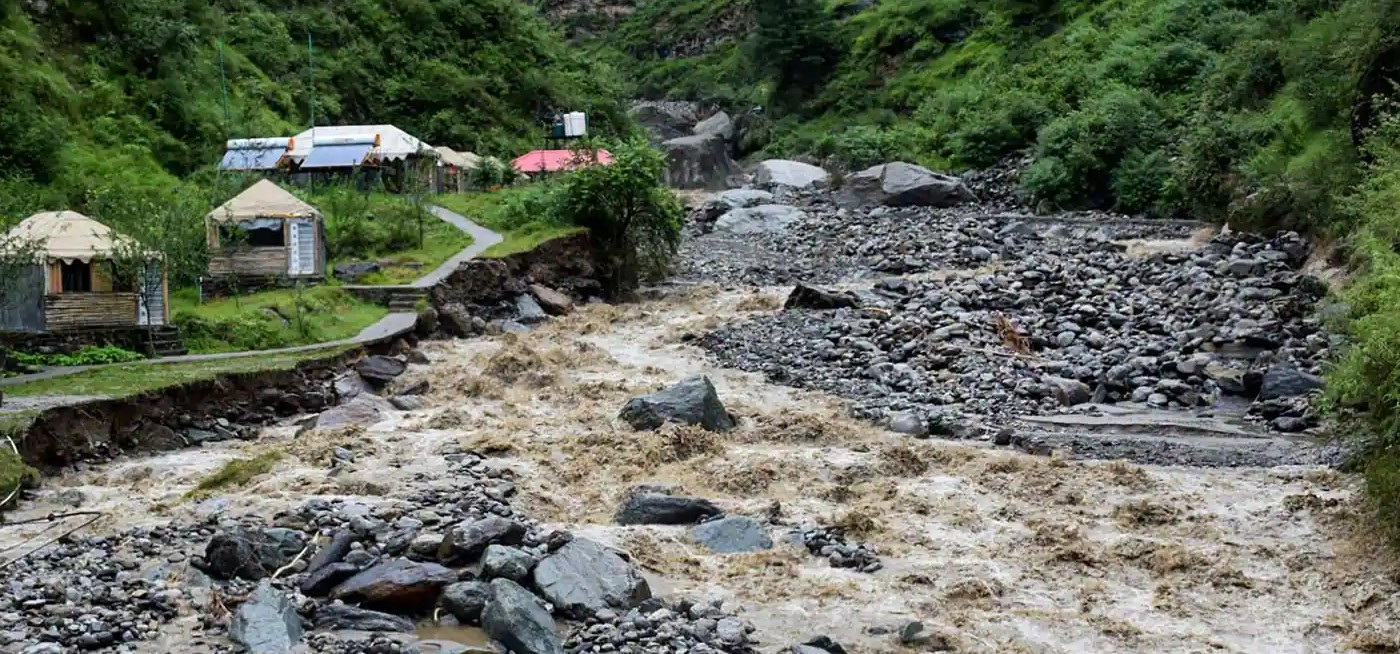Cyclone Mocha: Know How Climate Change Making Cyclones More Intense In Indian Seas
Researchers and scientists have been blaming increasing global mean temperature behind the changes in the cyclogenesis, particularly over Indian Ocean.
By Editorial Team / May 15, 2023
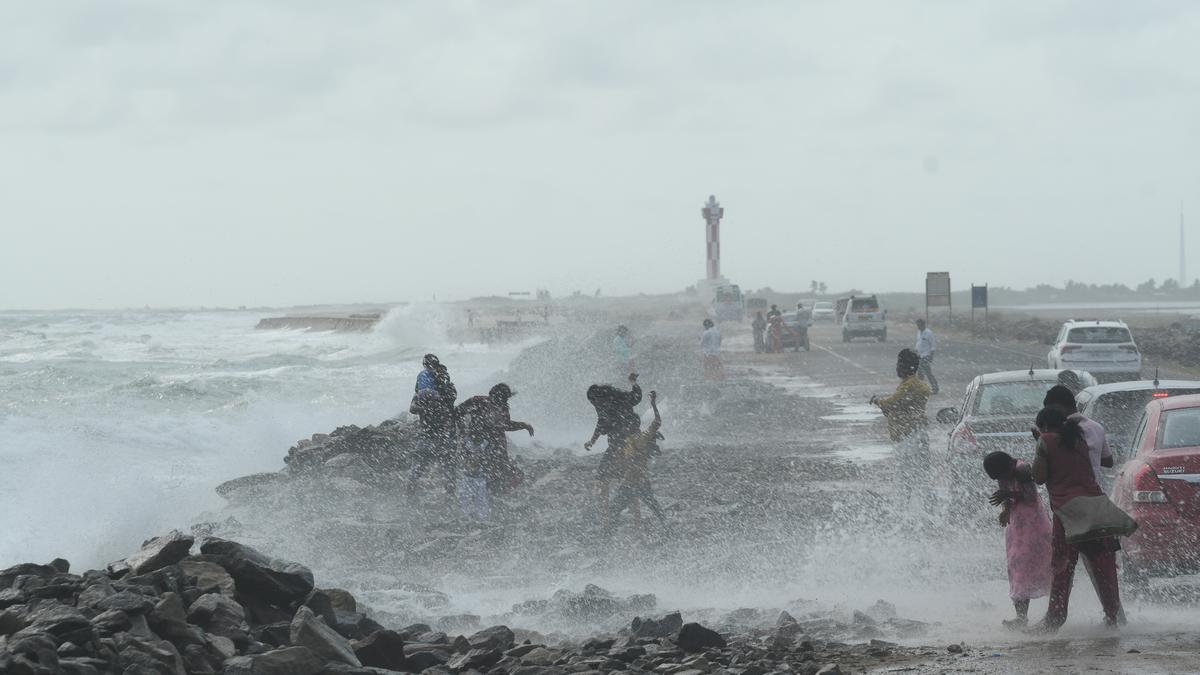
Image Credit: The Hindu
India witnessed its maiden cyclonic storm of the season ‘Cyclone Mocha’ in Bay of Bengal during the second week of May. After travelling along the East Coast of India, Cyclone Mocha recurved eastwards and made landfall on May 14, 2023 between Kyaukpyu, Myanmar and Cox’s Bazar, Bangladesh close to north of Sittwe, Myanmar.
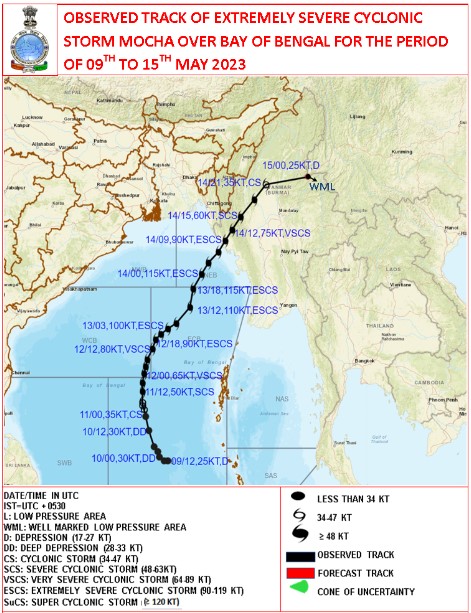
Image Courtesy: IMD
Meteorologists termed tropical storm Mocha as a very powerful storm, as it sustained the strength of extremely severe cyclone even at the time of hitting the coast. At the time of landfall, Mocha was accompanied with the wind speed of 180-190 kmph gusting to 210 kmph for at least two hours. Though storm weakened thereafter but maintained the intensity of a cyclonic storm for fair amount of time, increasing the quantum of destruction.
While country’s nodal agency, India Meteorological Department (IMD) limited Cyclone Mocha to an ‘extremely severe storm’, Joint Typhoon Warning Centre at Hawaii (US-PACAF) upgraded the storm equivalent to a Cat-V hurricane for a few hours between the 13th May late night and 14th May morning. The purple colour track in the picture relates to the Super Cyclone duration, over the open sea well before the landfall.
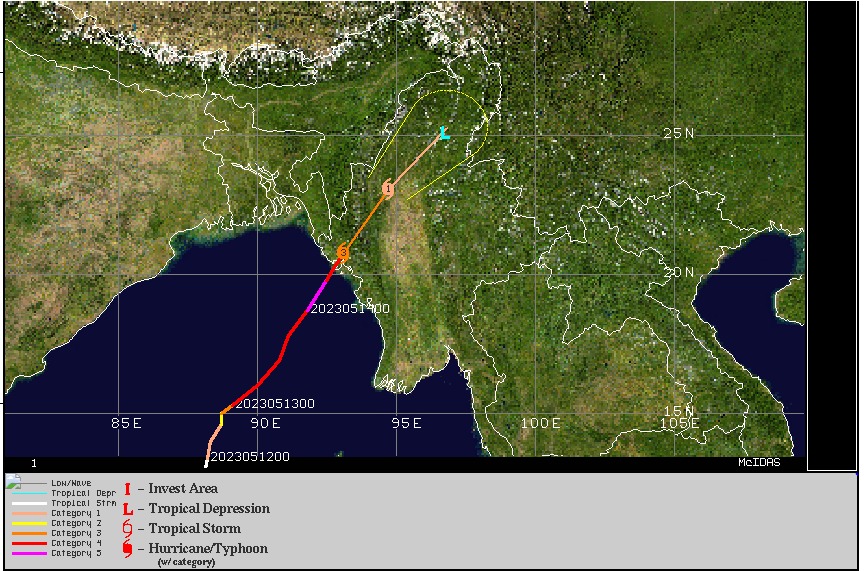
Image Courtesy: JTWC
Changing cyclone mechanism
May is the peak month for cyclogenesis in the Indian Ocean, hence the formation of the tropical cyclone is very timely. However, it is the rapid intensification of these storms is a matter of concern off late. Researchers and scientists have been blaming increasing global mean temperature behind the changes in the cyclogenesis, particularly over Indian Ocean.
According to a study ‘Changing status of tropical cyclones over the north Indian Ocean’, the translation speed of cyclones (the speed at which cyclone moves) has decreased in the Arabian Sea. This means that cyclones are now moving slowly. The increase in cyclone activity in the Arabian Sea is tightly linked to the rising ocean temperatures and increased availability of moisture under global warming.
“Weather conditions in ocean are very supportive for the rapid intensification of the system. Though Bay of Bengal might have seen decline in cyclogenesis but intensity of the cyclones has increased by manifolds. Models are unable to pick up this rapid intensification of the cyclones because they do include ocean conditions properly and that is their limitations. Cyclones nowadays can retain their energy for quite long number of days. One example for this was Cyclone Amphan which continued to travel over the land for as a strong cyclone and led to huge devastation. As long as oceans are warm and winds are favourable, cyclones will retain their intensity for longer period,” said Dr Roxy Mathew Koll, Climate Scientist at the Indian Institute of Tropical Meteorology and Lead IPCC Author.
Dr Roxy further added, “Bay of Bengal has been riding on the wave of global warming during past few decades. Temperatures have been between 30-32 degrees Censius in Bay of Bengal. These high temperatures play very important role in intensification of the cyclonic storms as they infuse more amount of convection. This kind of rapid intensification has become frequent recently both in Arabian Sea as well as Bay of Bengal.”
Impacts of climate change on cyclogenesis: India Perspective
Tropical cyclones (TCs) are one of the most devastating natural disasters costing more than half a million lives all over the world in the last five decades. More than 75% of total TCs over the globe causing the human deaths of 5000 or more have occurred over the North Indian Ocean (NIO) during past 300 years. The threats from increasing cyclone activity with climate change have been reasonably well established. The Indian Ocean region, including the Arabian Sea (AS) and the Bay of Bengal (BoB) is of particular concern because of the high population density along its coastlines.

Image Credit: Nature
“Sea surface temperatures are increasing. Mechanism behind the formation of cyclones does not change but weather conditions are changing. Cyclones are intensifying at a faster pace in the recent past. The sole reason behind this is not just increase in the SSTs but rising ocean heat content (OHC). Earlier the system used to take 2-3 days before forming into a tropical storm but nowadays we changeover depression into cyclonic storm in just a day. Atmosphere not only interacts with SSTs but also with entire ocean. It is very much evident from the research that OHC is changing because of the climate change,” said Dr M M Ali, Meteorologist and Oceanologist, Andhra Pradesh State Disaster Management Authority and Emeritus Scientist G and Group Director – Atmosphere, ISRO (Indian Space Research Organisation).
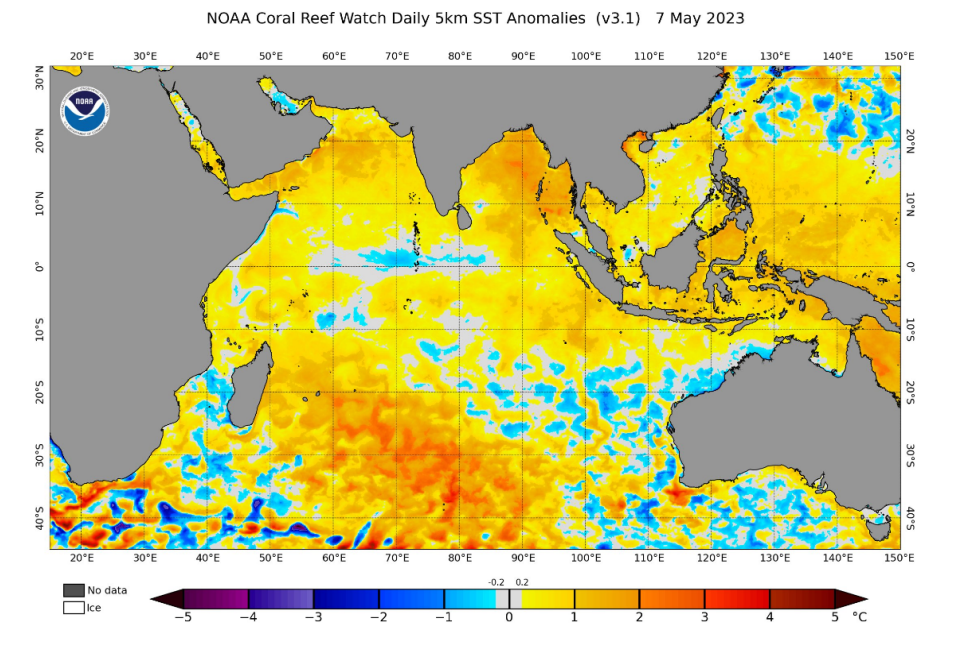
Image Credit: NOAA
The climate is changing primarily because of increased long-lived greenhouse gases in the atmosphere that have increased radiative forcing of the climate system, according to the IPCC’s Special Report on Ocean and Cryosphere in a Changing Climate (SROCC). A consequence is an energy imbalance at the top of the atmosphere of which about 92% goes into the ocean, increasing OHC. Primary indicators of a changing climate include increases in global mean surface temperature, sea level, and Ocean Heat Content (OHC).
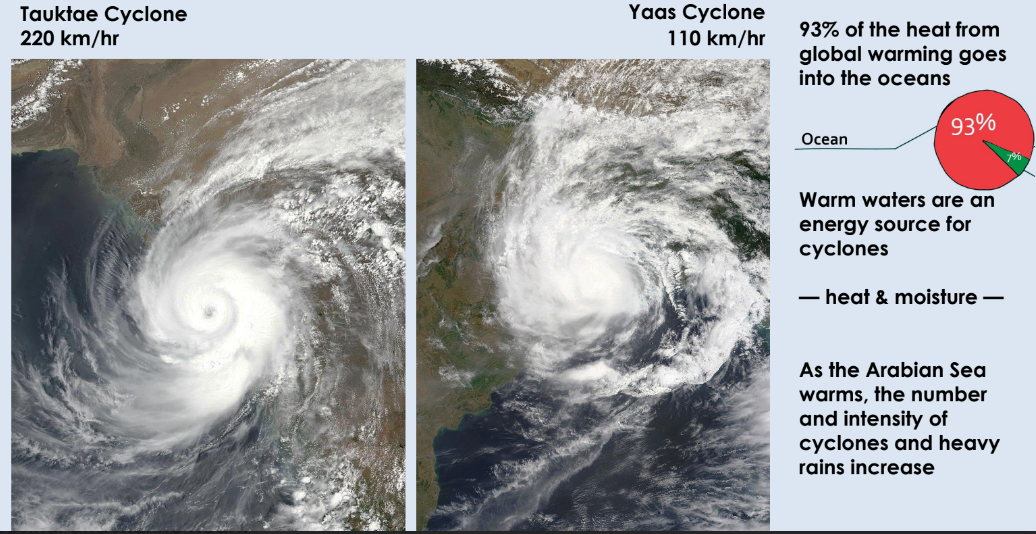
At the ocean surface, temperature has, on average, increased by 0.88 [0.68 to 1.01] °C between 1850–1900 and 2011–2020, with 0.60 [0.44 to 0.74] °C of this warming having occurred since 1980. The ocean surface temperature is projected to increase between 1995 to 2014 and 2081 to 2100 on average by 0.86 [0.43 to 1.47, likely range] °C in SSP1-2.6 and by 2.89 [2.01 to 4.07, likely range] °C in SSP5-8.5. Since the 1950s, the fastest surface warming has occurred in the Indian Ocean. The Ocean heat content has increased from 1971 to 2018 by 0.396 [0.329 to 0.463, likely range] yottajoules and will likely increase until 2100 by two to four times that amount under SSP1-2.6 and four to eight times that amount under SSP5-8.5.
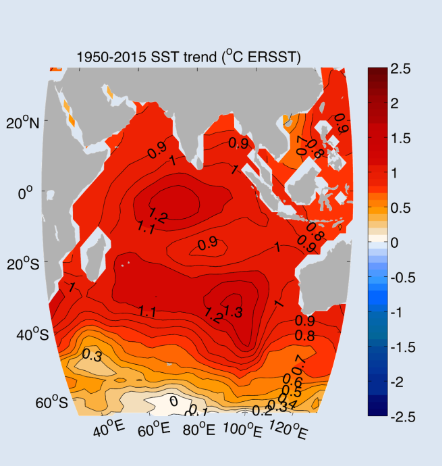
Image Credit: IPCC
According to IPCC’s Special Report on Ocean and Cryosphere in a Changing Climate (SROCC), both Sea Surface Temperatures (SST) and OHC are projected to increase in the future. There will be a warmer and wetter world over oceans and more energy available for evaporation, facilitating more TC activity and more rainfall. There may be fewer but more intense storms (i.e., relatively more Category 4/5 storms), in part because of changes in atmospheric stability, and in part because a few bigger storms can replace many smaller storms in terms of their impact on the ocean.
“Barrier Layer is a layer between the top and bottom layers of the ocean. This layer is getting stronger with increasing OHC and hence heat is not penetrating to the bottom layer of the ocean. Cyclones follow OHC and tracks where is it is more. That is what we have seen in Arabian Sea and Bay of Bengal, wherein usually cyclones tend to weaken as they track near the coast on account of increasing wind shear and less moisture. However, these days cyclones tend to hold on to their strength even when they are near the coast. This is the serious threat to the Indian coasts on either sides,” added Dr Ali.
Importance of Ocean Heat Content for Cyclone Studies
The input parameters that used into the models as a source of energy for the cyclones need to be reconsidered. Model estimate the energy for cyclones as latent heat release through evaporation computed using only SST. However, the energy in the ocean for cyclone is available in the upper layers of the oceans rather than in the skin layer represented by SST. The results obtained during the series of analysis emphasized that the thermal structure of the upper ocean is more critical and sensitive predictor for cyclones compared to SST, which need to be incorporated in numerical models for better and accurate forecasting. These analyses indicate that OHC act as a more important predictor than SST to estimate the life cycle of a cyclone through pressure drop, track change, intensity and to predict storm surge height. This parameter also explains the increasing number of intensifying cyclones. Since the atmosphere interacts with the ocean through SST, a better parameterization of SST that takes into account the OHC is required to be developed. It is well recognized that sea surface temperature (SST) plays a dominant role in the formation and intensification of tropical cyclones.
Cyclone Mocha Cyclone in Bay of BengalClimate Change Ocean Warming
